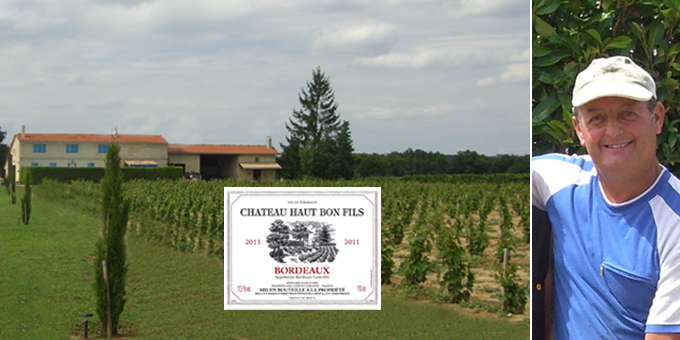
Portrait of
Bernard Daraignes
Owner of ChâteauHaut Bonfils
THE PROPERTY WAS BOUGHT IN 1960 BY MR AND MRS ABEL DARAIGNÉS, WHO PLANTED 4 HA OF VINES. IN 1979 THEIR SON BERNARD TOOK OVER 1 HA OF THE ESTATE AND THE NAME CHÂTEAU HAUT BONFILS, ON THE HEIGHTS OF THE AREA CALLED BONFILS.
Our meeting took place on an estate steeped in history and resolutely turned towards nature. It was surrounded by a hen and her wandering chicks, under the watchful eye of a Scottish cow, that I started my entertaining interview.
Bernard, your estate breathes with the joys of life, what is your secret?
«As you can see around you, these animals account for a large part of it. My wife and I have goats, chickens, dogs and a Highland cow. All are named after foods or fruit: “Tartine”, “Cerise”, “TitiPomme”, “Biscotte”, “Pain d’épice” not forgetting “Kama” the mare… Who works the vineyard across the seasons. Animals are a family tradition, and my father already worked with “Ilka”, a Percheron draught horse. Growing vines is a real passion, I talk to them, watch them grow, I work in the vineyard for 90% of my time, they are my life and so I take care of them…»
You practise responsible farming, how does that work in reality?
«I have built equipment to work the plots organically, I weed the vineyard rather than using herbicides, I use rain water and have a device to correct the pH of the water so that I can use the strict minimum of sprays. The estate is 100% certified Agri Confiance.»
Why do you work with a co-operative?
«I like nature, so I prefer to have more vines and to work them properly rather than splitting my time between growing and vinification. Entrusting vinification to the co-op allows me to carry out my trade and to do so correctly.»
What is the history of your vineyard?
«The origins of the Bonfils place name in Espiet come from a family of immigrants who arrived in the Entre-Deux-Mers after the Hundred Years War. In fact the military devastation of the crops and peasant population had led to an exodus from the parishes of Espiet and Camiac. After the conflict, the lords of the region tried to repopulate them. The Abbey of La Sauve-Majeure, owner of a large part of the lands located in these two parishes, entrusted several abandoned estates to families from western central France. Thus it was that Pierre Bonfils arrived in Camiac, on abandoned lands that he had to clear and bring back into cultivation. The Bonfils family chose to live in the Granges locality where
they had a new house built at the start of the 16th century. Old dwellings from the period survive to this date, the last evidence of the family that gave its name to Bonfils, which today has a large and prosperous vineyard of 49 Ha made up of Cabernet Sauvignon, Cabernet France, Merlot and Sémillon.
How do you see the future?
«Well here is my daughter Leslie, 24 years old and a student of biology and ecology in Canada. My wife and I have just handed over 15 Ha of vineyard to her. She will be the third generation to cultivate our land.»
Leslie, what do you think of this new development?
«I am proud to take on a part of the family business, I grew up in the vines and they are my roots. My studies in biology will allow me to further carry on the integrated farming that my grandfather and father have developed. It is important for us to continue to let our heritage live and to enlarge it.»




